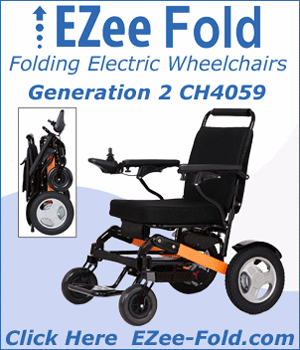Wheelchair Measuring Guide
Long Version - for short version click here
Wheelchair measurements are critical for everyday wheelchair users to have a comfortable and functional piece of equipment which will meet all their needs and provide for the best possible results. This guide is by no means etched in stone and often there are circumstances which require ignoring the basic rules of thumb for measuring a wheelchair however this guide is applicable to 90% of the wheelchair user population.
Wheelchair Seat Width
Seat width is usually the first measurement determined when fitting a person for a wheelchair. This measurement is decided by taking the widest point between the hips and the knees when sitting comfortably and adding about 1". When referring to a wheelchair as an 16", 18" or 20", which are the most common sizes, people in the wheelchair industry are referring to the usable seat width, not the overall width of the wheelchair.
Wheelchair Overall Width
Normally, the narrower the overall wheelchair width the more responsive it is and overall width is determined by adding the width of the seat to the width of the wheels, arms and any extra seating required. The trade off for a narrow wheelchair is that it is less stable from side to side but this tippiness can be accommodated by lowering seat height to lower the center of gravity or cambering the rear wheels to make a wider base measurement.
Make, model and style of wheelchair will have a bearing on the overall width and an 18" wheelchair from company "A" might have a different overall width than an 18" wheelchair from company "B" just as the overall width of an 18" power wheelchair will be different than the overall width of an 18" manual wheelchair.
Wheelchair Seat Depth
Seat depth is probably the second most important measurement which must be considered. The seat depth measurement of the user is determined by measuring from the back of the user's pelvis to the back of their shins when sitting straight with the lower legs dropping at 90 degrees from their knees. The longer the seat depth of the wheelchair, the more stable the user will be and their weight will be distributed over a larger area which in turn will reduce sitting discomfort.
The seat depth of the wheelchair is determined by subtracting about 1" from the user's seat depth for most manual and power wheelchairs. In cases where the wheelchair users use their feet to aid in propulsion or maneuvering of the wheelchair, one would normally subtract about 2" from the user's seat depth to determine the wheelchair seat depth so the upper calves of the user don't rub against the seat of the wheelchair when propelling the chair.
Some user's may have what's known as a leg length discrepancy which means that one leg is longer than the other. leg length discrepancy can be caused by either a physical shortness on one leg or being unable to sit with the pelvis flat against the wheelchair back support. When considering seat depth for a wheelchair, the user's shorter leg will determine the wheelchair seat depth. If the longer leg isn't well enough supported with the shorter seat depth, extra support for that leg can be achieved buy ordering a custom seat cushion which extends farther forward on the longer leg side.
Wheelchair Overall Depth
As with overall wheelchair width, overall wheelchair depth is largely determined by the choice of seat depth however some models of wheelchair have adjustable rear wheels or casters which can be moved to fine tune the wheelchair's overall length for the user. Also as with overall wheelchair width, smaller overall wheelchair depth will make the chair more responsive and maneuverable but again tippiness increases.
Wheelchair Seat Height
Seat height is more about function than comfort. Ideally the seat height will put the user at a height that will allow them to work at a table or desk comfortably and enabled transfers to toilets, commodes, beds and other chairs and also provide enough ground clearance for the different types of terrain the user may travel over. When discussing seat height in respect to wheelchairs the seat height of the chair does not include the thickness of the wheelchair cushion. So, if you need a 19" seat height and your cushion is 2" thick you would order a wheelchair with a 17" seat height.
Wheelchair Footrest Length
As with seat width and depth, footrest length determination begins with the user's seat height. When sitting with their legs hanging straight down from their knees and feet flat on the floor the user's seat height is measured from the bottom of their heel to underside of their thigh at the back of the knee. From this measurement we subtract the thickness of the wheelchair cushion when compressed the wheelchair user will be using (usually 1" to 3"). This gives us the distance from the front edge of the seat upholstery to the foot plates we will need.
If the footrest length doesn't allow for enough ground clearance you have a couple of options for compromise. One, you can choose a footrest with a smaller hanger angle. Hangers are the bars which the foot plates are attached to and hanger angles are normally 90, 70 or 60 degrees for most models of wheelchair. A 90 degree hanger angle is perpendicular to the floor or 90 degrees to the floor. A 70 degree hanger is angled at about 70 degrees when measured from the floor and 60 degree hangers are measured at 60 degrees from the floor. The second option is to use the adjustments available on many wheelchairs to change the position of the casters and rear wheels which will change the ground clearance but this will also change the seat height.
Wheelchair Back Height
Back height will vary from user to user and wheelchair type to wheelchair type. People with good upper body control and posture can get away with low back heights from just above the pelvis to the mid back level. Users who require more back support should opt for a higher back height but if they propel their wheelchair with their arms too high a back height will impede the range of motion in their shoulders which will reduce the efficiency of their pushing their chair. People who require a lot of support and use power wheelchairs, or aren't self-proprlling, should have a back height as high as their shoulders, if needed. In cases where the wheelchair has a tilt or recline function the back height should be at least to the top of the shoulders and have an extension or a headrest added to support the user's head. Most models of wheelchairs offer some type of back height adjustment of up to 4" for fine tuning after delivery.



 Online Vendors
Online Vendors  US Online Vendors
US Online Vendors 

